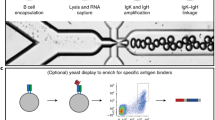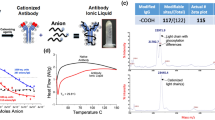Abstract
Culture conditions affect the binding activity, charge heterogeneity, conformational stability, glycosylation, and pharmacokinetics of human monoclonal IgM HMAB-10058. The 10058 human/human/murine trioma was grown in serum-free airlift suspension culture, hollow fiber perfusion culture, or in nude mouse ascites. The ascites-produced antibody showed reduced conformational stability, greater charge and glycoform heterogeneity, and a lower average degree of sialylation than the in vitro culture-produced material. Mean residence time after IV injection in rats was approximately 80-fold greater for the ascites culture-produced material, but specific binding activity was less than 5% of that for the airlift-produced material. In vitro culture in serum-supplemented media (in a hollow fiber perfusion reactor or in shake-flasks) resulted in antibody with pharmacokinetics intermediate between the serum-free airlift and ascites-produced materials. Incubation of airlift-produced antibody in ascites fluid also resulted in material with intermediate pharmacokinetics. Conclusions regarding the effect of culture conditions on antibody product cannot be generalized, as in vitro-produced antibody derived from two related cell lines (HMAB-10233 and HMAB-10390) had long mean residence times similar to that of ascites-produced HMAB-10058.
This is a preview of subscription content, access via your institution
Access options
Subscribe to this journal
Receive 12 print issues and online access
$209.00 per year
only $17.42 per issue
Buy this article
- Purchase on Springer Link
- Instant access to full article PDF
Prices may be subject to local taxes which are calculated during checkout
Similar content being viewed by others
References
Gauny, S.S., Andya, J., Thomson, J., Young, J.D. and Winkelhake, J.L. 1991. Effect of production method on the systemic clearance rate of a human monoclonal antibody in the rat. Hum. Antibod. Hybridomas 2: 33–38.
Davis, A.C. and Shulman, M.J. 1989. IgM—Molecular requirements for its assembly and function. Immunology Today 10: 118–128.
Muraoka, S. and Shulman, J. 1989. Structural requirements for IgM assembly and cytolytic activity. 1989. J. Immunology 142: 695–701.
Shimizu, A., Putnam, F.W., Paul, C., Clamp, J.R. and Johnson, I. 1971. Structure and role of the five glycopeptides of human IgM immunoglobulins. Nature 231: 73–76.
Krotkiewski, H., Nilsson, B. and Svensson, S. 1989. Structural analysis of the carbohydrate chains of a mouse monoclonal IgM antibody. Eur. J. Biochem. 184: 29–38.
Goochee, C.F. and Monica, T. 1990. Environmental effects on protein glycosylation. Bio/Technology 8: 421–427.
Wold, F. 1981. In vivo chemical modification of proteins (post-translational modification). Ann. Rev. Biochem. 50: 783–814.
Manning, M.C., Patel, K. and Borchardt, R.T. 1989. Stability of protein Pharmaceuticals. Pharmaceutical Res. 6: 903–918.
Thall, A. and Galili, U. 1990. Distribution of gal α-(1,3) β-(1,4) glcNAc residues on secreted mammalian glycoproteins. Biochemistry 29: 3959–3965.
Anderson, D.R., Atkinson, P.H. and Grimes, W.J. 1985. Major carbohydrate structures at five glycosylation sites on murine IgM determined by high resolution H-NMR spectroscopy. Arch. Biochem. Biophys. 243: 605–618.
Megaw, J.M. and Johnson, L.D. 1979. Glycoprotein synthesized by cultured cells: effects of serum concentrations and buffers on sugar content. Proc. Soc. Exp. Biol. and Med. 161: 60–65.
Moellering, B.J., Tedesco, J.L., Townsend, R.R., Hardy, M.R., Scott, R.W. and Prior, C.P. 1990. Electrophoretic differences in a MAb expressed in three media. BioPharm 3: 30–38.
Rao, P., Williams, A., Baldwin-Ferro, A., Hanigan, E., Kroon, D., Makowski, M., Meyer, E., Numsuwan, V., Rubin, E. and Tran, A. 1991. C-terminal modification occurs in tissue culture produced OKT3. BioPharm 4: 38–43.
Wallick, S.C., Kabat, E.A. and Morrison, S.L. 1988. Glycosylation of a VH residue of a monoclonal antibody against α(1-6) dextran increases its affinity for antigen. J. Exp. Med. 168: 1099–1109.
Winkelhake, J.L. and Chang, R.J. 1979. Structural determinants for the circulating lifetime of antibodies and immune complexes, p. 153. In: Protides of the Biological Fluids. H. Peeters (Ed.). Pergamon Press, New York.
Cohen, G.L. and Mannik, M. 1966. Catabolism of G-globulin with reduced interchain disulfide bonds in rabbits. J. Immunol. 96: 683–690.
Ashwell, G. and Morell, A.G. 1974. The role of surface carbohydrates in the hepatic recognition and transport of circulating glycoproteins. Adv. Enzymol. 41: 99–128.
Ashwell, G. and Harford, J. 1982. Carbohydrate-specific receptors of the liver. Annu. Rev. Biochem. 51: 531–554.
Lehrman, M.A., Pizzo, S.V., Imber, M.J. and Hill, R.L. 1986. The binding of fucose-containing glycoproteins by hepatic lectins. J. Biol. Chem. 261: 7412–7418.
Day, J.F., Thornburg, R.W., Thorpe, S.R. and Baynes, J.W. 1980. Carbohydrate-mediated clearance of antibody antigen complexes from the circulation. J. Biol. Chem. 255: 2360–2365.
Pollack, M., Raubitschek, A.A. and Larrick, J.W. 1987. Human monoclonal antibodies that recognize conserved epitopes in the core-lipid A region of lipopolysaccharides. J. Clin. Invest. 79: 1421–1430.
Maiorella, B.L., Inlow, D. and Howarth, W. 1989. Method of increasing product expression through solute stress. European patent application WO89/04867.
Howarth, W., Maiorella, B.L. and Inlow, D. 1990. Cell culture medium for enhanced cell growth, culture longevity and product expression. European patent EP 435,911.
Maiorella, B.L., Howarth, B., Shauger, A., Harano, D. and Inlow, D. 1989. Medium design: a new look at “feeding the baby”. Proceedings, cell Culture Engineering II, Engineering Foundation Conferences, New York.
Meldrum, A. 1987. Hollow fibre membrane reactors. The Chemical Engineer 441: 28–30.
Markwell, M.A. 1982. A new solid-state reagent to iodinate proteins. Anal. Biochem. 125: 427–432.
Skibba, J.L., McKean, L.P. and Winkelhake, J.L. 1983. Effects of hyperthermia on plasma glycoprotein catabolism by the isolated, perfused rat liver. Compar. Biochem. Physiol. 75A: 391–395.
Kabat, E.A. and Mayer, M.M. 1961. Experimental Immunochemistry, p. 135–153. Charles C. Thomas Publisher, Springfield, IL.
Grassetti, D.R. and Murray, J.F. Jr. 1967. Determination of sulfhydryl groups with 2,2-or 4,4–dithiodipyridine. Arch. Biochem. Biophys. 119: 41–49.
Chowdhry, B.Z. and Cole, S.C. 1989. Differential scanning calorimetry: applications in biotechnology. Trends in Biotech. 7: 11–18.
Ashford, D., Dwek, R.A., Welpy, J.K., Amatayakul, S., Homans, S.W., Lis, H., Taylor, G.N., Sharon, N. and Rademacher, T.W. 1987. The beta (1,2) D-xylose and alpha (1,3) L-fucose substituted N-linked oligosaccharides from Erythina cristagalli lectin. Eur. J. Biochem. 166: 311–320.
Parekh, R.B., Tse, A.G., Dwek, R.A., Williams, A.F. and Rademacher, T.W. 1987. Tissue-specific N-glycosylation, site-specific oligosaccharide patterns and lentil lectin recognition of rat Thy-1. EMBO J. 6: 1233–1244.
Parekh, R.B., Dwek, R.A., Thomas, J.R., Opdenakker, G., Rademacher, T.W., Wittwer, A.J., Howard, S.C., Nelson, R., Siegel, N.R. and Jennings, M.G. 1989. Cell-type-specific and site-specific N-glycosylation of type I and type II human tissue plasminogen activator. Biochemistry 78: 7644–7662.
Chaplin, M.F. 1982. A rapid and sensitive method for the analysis of carbohydrate components in glycoproteins using gas-liquid chromatography. Anal. Biochem. 123: 336–341.
Ciucanu, I. and Kerek, F. 1984. A simple and rapid method for the permethylation of carbohydrates. Carbohydr. Res. 131: 209–217.
Author information
Authors and Affiliations
Rights and permissions
About this article
Cite this article
Maiorella, B., Winkelhake, J., Young, J. et al. Effect of Culture Conditions on IgM Antibody Structure, Pharmacokinetics and Activity. Nat Biotechnol 11, 387–392 (1993). https://doi.org/10.1038/nbt0393-387
Received:
Accepted:
Issue Date:
DOI: https://doi.org/10.1038/nbt0393-387
This article is cited by
-
Structural analysis of N- and O-glycans released from glycoproteins
Nature Protocols (2012)
-
Related effects of cell adaptation to serum-free conditions on murine EPO production and glycosylation by CHO cells
Cytotechnology (2007)
-
Getting the glycosylation right: Implications for the biotechnology industry
Nature Biotechnology (1996)
-
Removal of Sialic Acid from a Glycoprotein in CHO Cell Culture Supernatant by Action of an Extracellular CHO Cell Sialidase
Nature Biotechnology (1995)
-
Effect of lipid supplements on the production and glycosylation of recombinant interferon-? expressed in CHO cells
Cytotechnology (1994)



